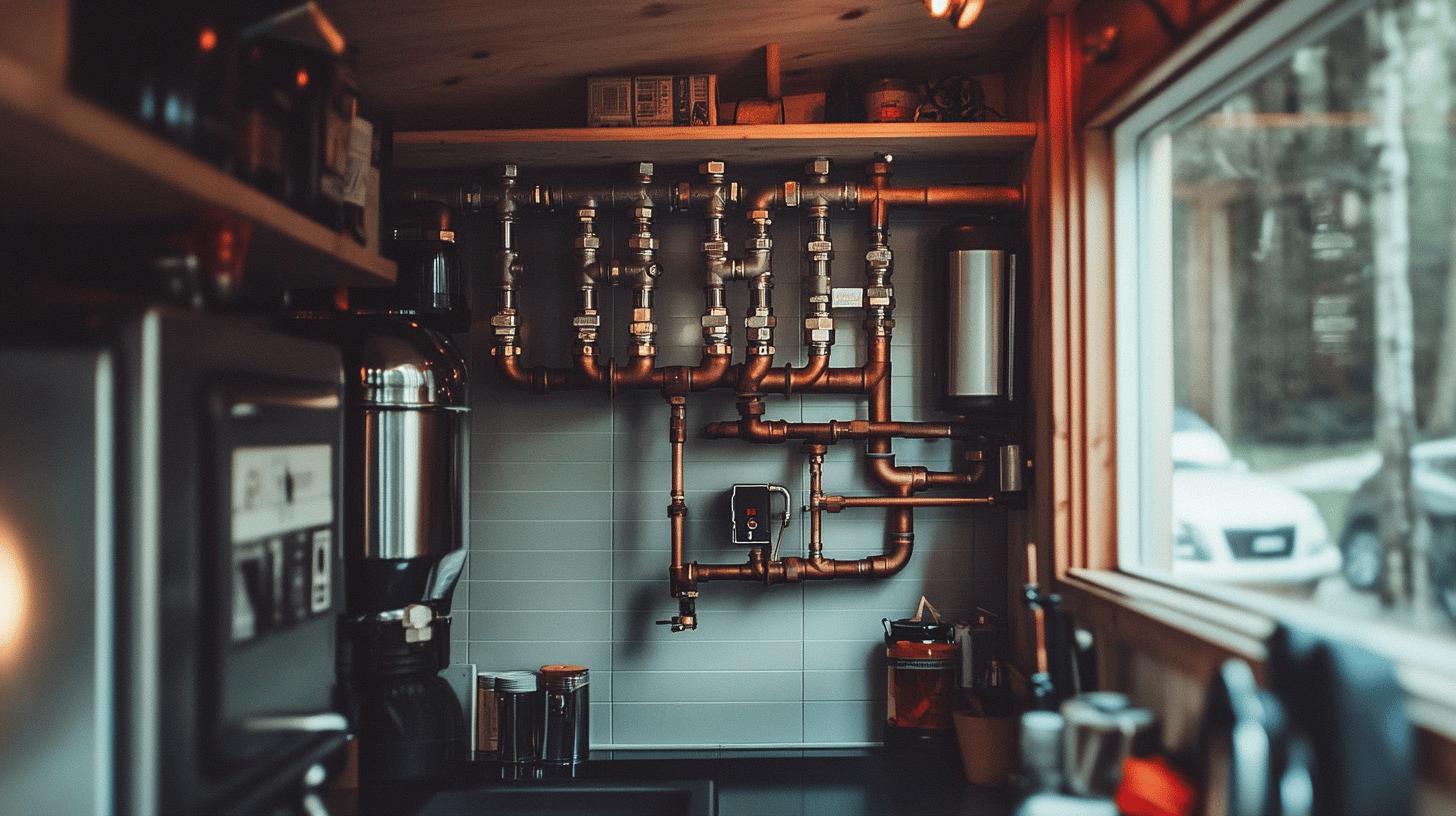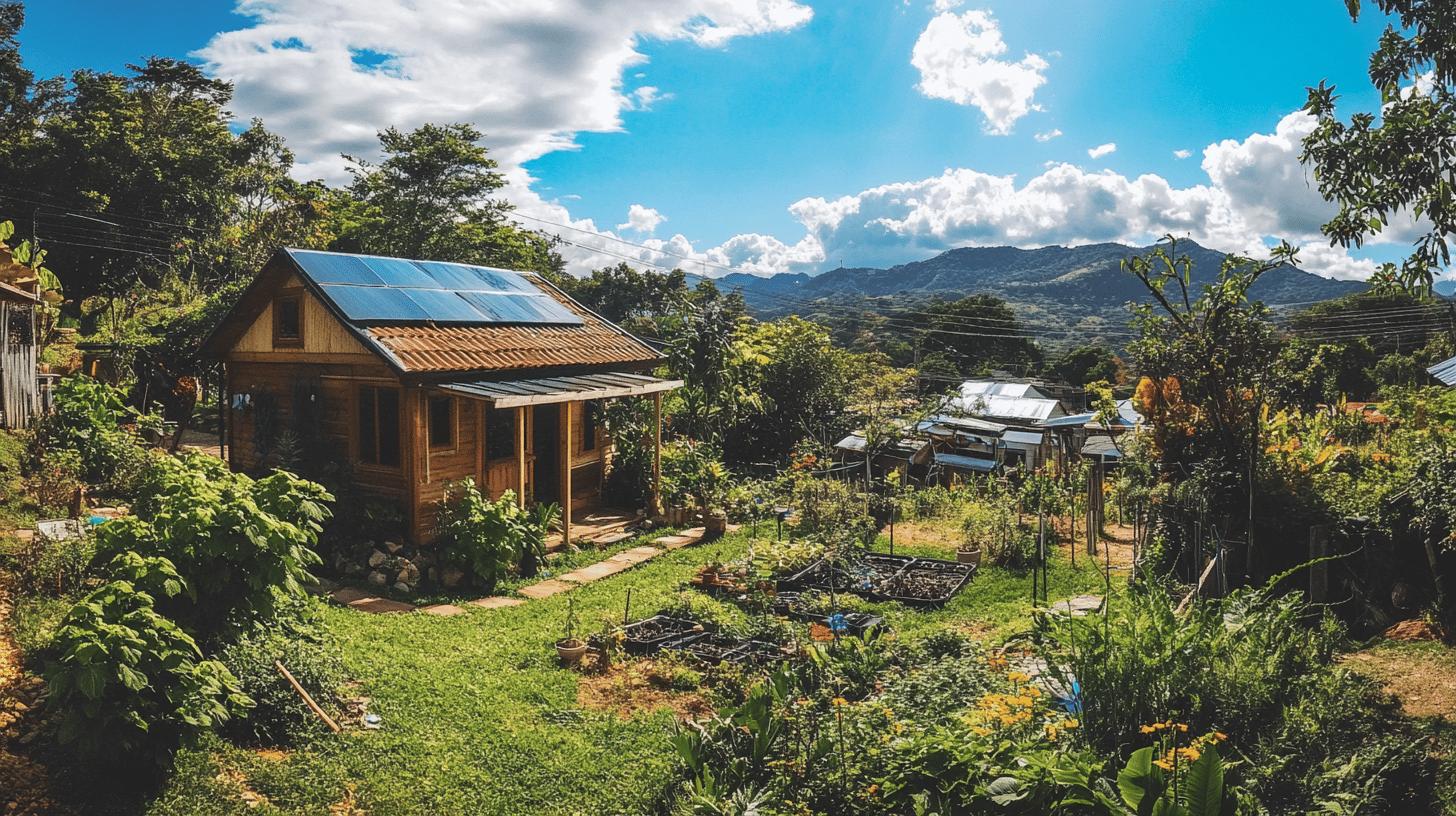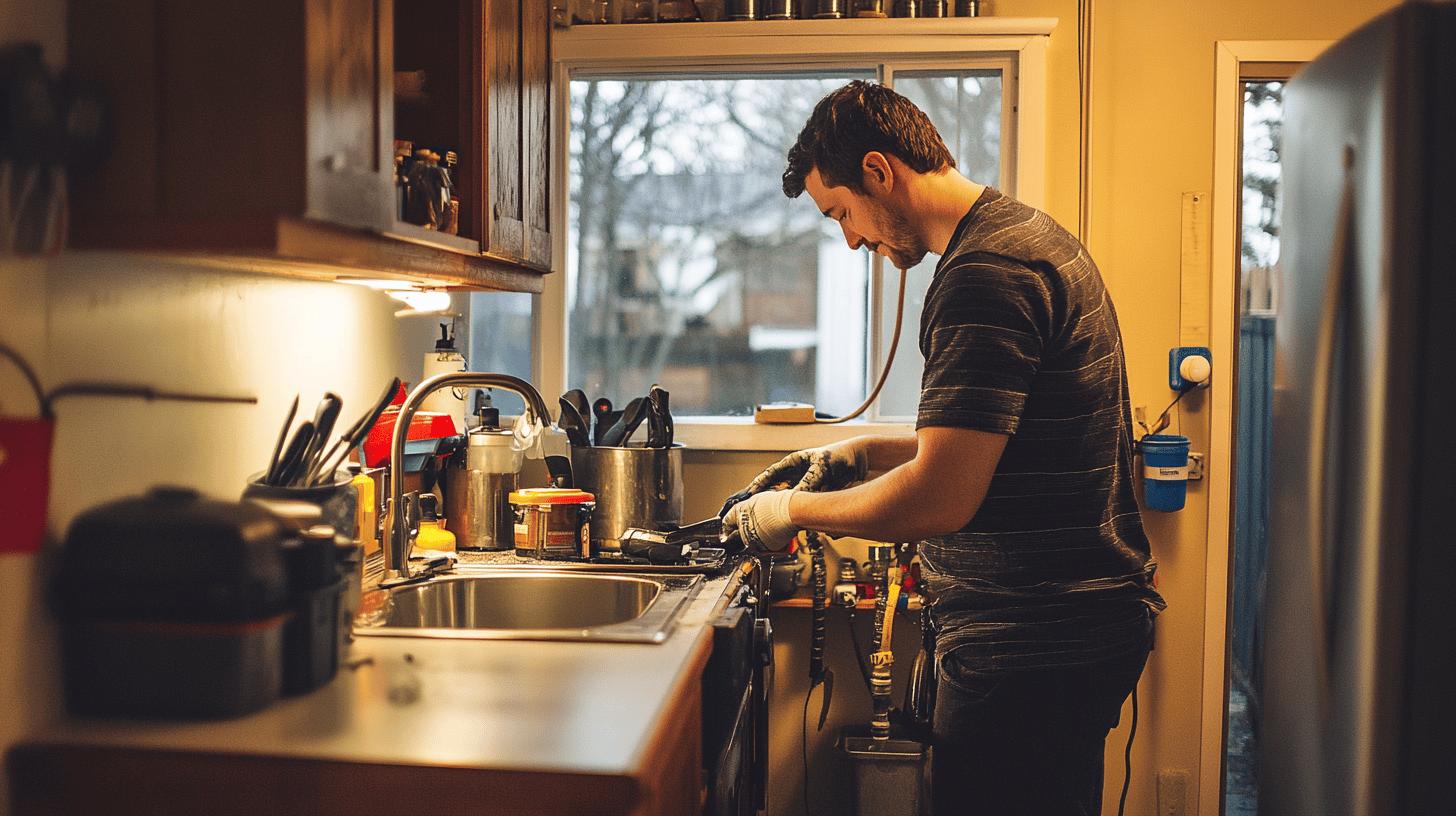TL;DR:
- Tiny home plumbing typically includes: sink, shower, toilet.
- Uses PEX piping (flexible, freeze-resistant) and tankless water heaters.
- Water supply options:
- No plumbing (manual water)
- Tank and pump system (pressurized water)
- Direct hookup (municipal water)
- Hybrid system (combines both)
- Wastewater management through gray water systems, composting toilets, portable tanks, or incinerating toilets.
- Cost-effective solutions: use PEX/PVC, minimize drain lines, opt for tankless heaters, and consider DIY.
- Hiring professional plumbers ensures code compliance and proper installation (cost: $100-$200/hour).
Ever think about how plumbing works in tiny homes? It’s actually pretty simple. Tiny homes stick to the basics—one sink, a shower, and a toilet. No big maze of pipes here! They usually use PEX plumbing because it’s flexible, doesn’t freeze easily, and works great in small spaces. This setup keeps things efficient and reliable, so your tiny home stays cozy and functional. Let’s break it down and make your plumbing easy!
Understanding Plumbing in Tiny Homes
Plumbing in tiny homes is all about keeping it simple. Most setups include just one sink, a shower, and a toilet. This basic approach makes things easier and cheaper to manage. Since space is tight, everything needs to be placed smartly to work well. The goal? To keep the comfort of a regular home while fitting it into a much smaller space.
- Sink
- Shower
- Toilet
- PEX piping
- Tankless water heater
Plumbing in tiny homes is way simpler than in regular houses. With fewer fixtures and smart use of space, it’s easier to manage. PEX pipes are a popular choice because they’re flexible, freeze-resistant, and perfect for tight spots. Pair that with a tankless water heater, and you’ve got hot water on demand without taking up a ton of room. It’s all about efficiency and practicality!
Designing Efficient Plumbing Systems for Tiny Homes

Good plumbing in a tiny home starts with smart planning. You need to figure out where everything goes without messing with the structure, like joists, especially for bathroom fixtures. Placing plumbing parts carefully makes everything work better and keeps the space feeling open.
Keeping things organized is super important. Use vertical space and group fixtures close together to cut down on pipes, which means fewer leaks and easier fixes. A well-thought-out setup keeps your plumbing simple, efficient, and space-friendly.
| Component | Space-Saving Strategy |
|—————|—————————————|
| Sink | Wall-mounted or foldable designs |
| Shower | Corner installation with compact units|
| Toilet | Composting or incinerating models |
| Water Heater | Tankless, mounted above or below sinks|
Keeping extra materials on hand is a smart move. It helps you handle unexpected problems without slowing down. Having spare supplies means you can adjust plans or add parts as needed. Spending a bit more at the start can save time and money by keeping your project on track.
Water Supply Options for Tiny Homes
Water supply in tiny homes needs careful planning, especially if you’re off-grid or always on the move. Options range from no plumbing at all to advanced systems that mix different methods. The best choice depends on how mobile you are and how close you are to a water source. Each setup has its pros and cons, so pick what works best for your lifestyle.
-
No plumbing
This is the simplest and most affordable option, with no internal plumbing setup. Residents bring water into their homes manually, suitable for minimalists near a water source. -
Tank and pump system
Balancing independence and convenience, it gives pressurized water like in traditional homes. It supports off-grid living by storing water in tanks and using a pump. -
Direct hookup
Best for stationary tiny homes or those near water sources, this involves connecting to a municipal water supply. It offers constant water access but limits mobility.
- Hybrid system
Combining tank and pump systems with direct hookups, these offer flexibility for both on and off-grid living. Ideal for adapting water supply to changing conditions.
Your water system should match your lifestyle. If you’re into off-grid living and moving around a lot, a tank and pump or hybrid system works great. If you prefer staying in one spot, a direct hookup gives you constant water without worrying about storage. Pick the setup that fits how you live and what you need in your tiny home.
Wastewater Management in Tiny Homes

Dealing with wastewater in tiny homes can be tricky because of their size and mobility. Unlike regular houses connected to sewer systems, tiny homes need creative, compact, and eco-friendly solutions that follow local rules. Your choice depends on your lifestyle and where you live, balancing comfort with sustainability.
Gray water systems handle water from sinks, showers, and washing machines. They’re great for reusing water for irrigation, but you’ll need to follow local laws to avoid contamination. Proper filtering keeps the environment safe.
Composting toilets are another popular option. They save space, don’t need water, and turn waste into compost, making them eco-friendly and simple to manage.
For blackwater, you could try portable waste tanks or incinerating toilets. Portable tanks store waste until you can dispose of it, while incinerating toilets turn waste into ash without using water. Just make sure whatever you choose fits your needs and follows regulations.
Cost-Effective Plumbing Solutions for Tiny Homes
Using PEX and PVC for plumbing in tiny homes is a smart way to save money. PEX is super flexible, easy to install, and resists freezing, making it perfect for tight spaces. This flexibility cuts down on labor costs. For drain lines, PVC is a durable and budget-friendly option. It’s affordable and easy to work with, helping you save on both materials and installation.
- Use PEX and PVC
- Minimize drain line length
- Opt for tankless water heaters
- DIY simple installations
Tiny homes naturally keep plumbing costs low because of their small size. With fewer fixtures and shorter piping, they use less material and require less labor. Plus, plumbing lines are easier to access, so there’s no need for expensive digging. These features make tiny home plumbing a budget-friendly solution.
The Role of Professional Plumbers in Tiny Home Projects

Hiring a professional plumber guarantees your tiny home’s plumbing meets all codes and is set up properly. Their expertise helps avoid mistakes and ensures everything runs efficiently. They know plumbing codes and safety rules, which is crucial for more complex systems. Trusting a pro gives you peace of mind, knowing everything is up to standard.
- Complex plumbing installations
- Ensuring code compliance
- Avoiding costly mistakes
Professional plumbing services typically cost $100 to $200 per hour. While it might seem pricey, it can save you from costly DIY mistakes. Unseen issues can lead to bigger problems down the road, which could end up costing more. Experts can spot these issues early, saving you time and money. For important tasks, hiring a pro is a smart investment in your tiny home’s safety and efficiency.
Final Words
Plumbing in tiny homes combines simplicity with smart design. The basic setup usually includes a sink, shower, and toilet, making the most of the small space. Effective planning and space-saving strategies are key to creating efficient plumbing layouts. Water supply options range from tank systems to direct hookups, depending on personal preferences. Wastewater management, through systems like greywater or composting toilets, provides eco-friendly solutions. Cost-effective materials like PEX and PVC help keep expenses low. Hiring a professional plumber ensures everything meets code and is installed correctly. With careful planning, tiny home plumbing can be both practical and efficient.
FAQ
How does plumbing work in tiny houses?
Plumbing in tiny houses typically involves a simple setup of a sink, shower, and toilet, using PEX piping for its flexibility and cold resistance, along with a tankless water heater for efficiency.
How much does it cost to get plumbing in a tiny home?
Tiny home plumbing costs vary, generally staying affordable with the use of PEX and PVC pipes and minimal drain lines, resulting in lower installation expenses compared to traditional homes.
How do tiny homes deal with sewage?
Tiny homes manage sewage by connecting to existing septic or sewer systems, using composting toilets to reduce blackwater, or employing grey water systems for lawful plant irrigation.
How do people in tiny houses get water?
Tiny houses acquire water through several options: no plumbing, tank and pump systems, direct hookups, or hybrid systems, each offering different benefits to suit varying lifestyle and mobility needs.
What are the types of plumbing used in tiny homes?
Plumbing in tiny homes typically includes PEX piping for supply lines, PVC for drains, tankless water heaters, and compact fixtures that maximize space and efficiency.
Are tiny homes with plumbing and electricity available for sale?
Tiny homes with both plumbing and electricity are available for sale, offering ready-to-live options with both essential utilities installed for convenience and comfort.
What does a tiny house plumbing kit include?
A tiny house plumbing kit generally consists of PEX or PVC pipes, fittings, valves, a compact water heater, and basic fixtures like a sink, showerhead, and toilet components.
What are cost-effective plumbing tips for tiny homes?
For budget-friendly tiny home plumbing, use PEX and PVC, minimize drain line lengths, choose tankless water heaters, and consider DIY installations for simple tasks.

